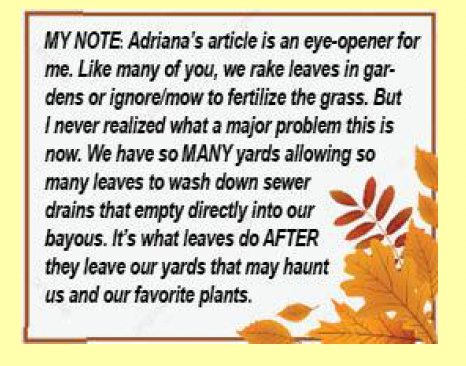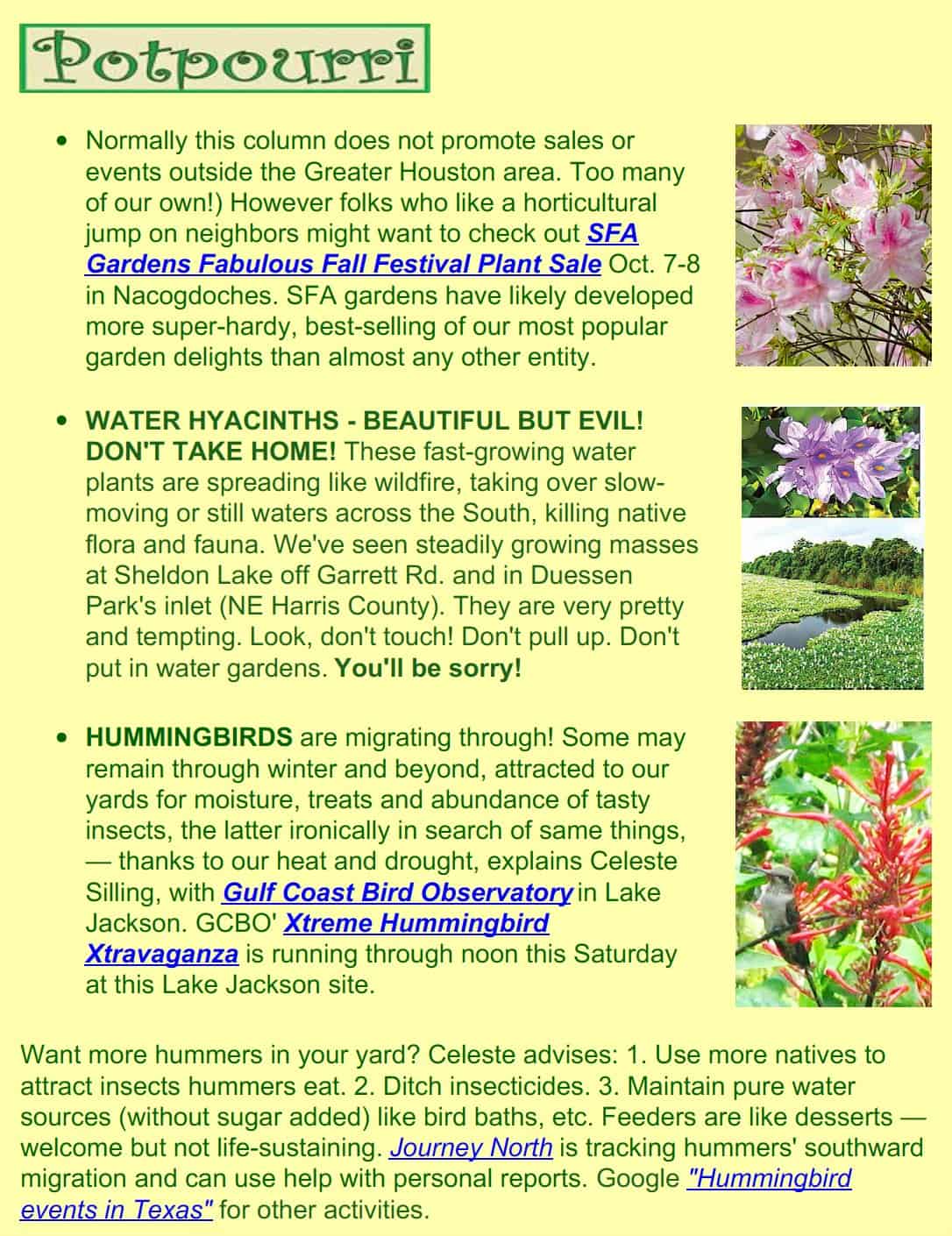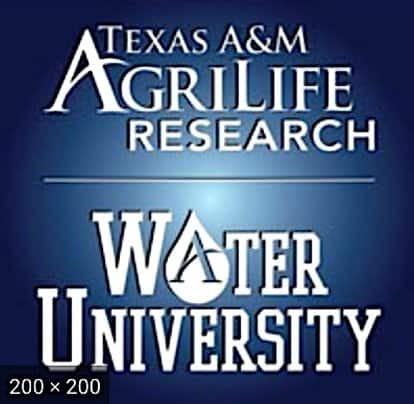

LEAVES IN BAYOUS, EDIBLES, HUMMER TIPS!
Brenda Beust Smith
DON’T LEAVE LEAVES WHERE THEY’LL WASH INTO OUR BAYOUS!
by ADRIANA MALVEAUX
BAYOU PRESERVATION ASSOCIATION
Water Quality Monitoring & Outreach Technician

Autumn is creeping up on us! After a scorching hot, dry summer, surviving trees are gearing up to drop leaves. It’s
that time when the world gets a breathtaking makeover with colorful leaves. But as per usual, there’s danger within that beauty.
Do you know what happens when fallen leaves end up in our bayous through those storm drains?
They let out chemicals while they break down – phosphorus and nitrogen to be exact. What’s the big deal? Brace yourself for potential algal blooms. These bursts of algae mess with oxygen levels in the bayou, and not in a good way.
As algae grows at excessive rates, it blocks light that is able to penetrate through water, killing most plant and algae life that isn’t close to the surface. As these dead plants and algae begin to decompose, oxygen is consumed resulting in lower oxygen levels for fish and invertebrates. Less oxygen means trouble for aquatic life, leading to the demise of various water-based plants and wildlife.
What can you do from your own backyard? Here are easy solutions to tackle the situation and give our bayous a literal breather:
Mow the leaves! Leftover pieces can be left behind to act as fertilizer for your entire yard! No bagging, no raking, no bending over, and the leaves are reused!
Grab that rake, collect those leaves, and bag them. Have a composter? Leaves can become natural plant fertilizer. Some cities or neighborhoods have dedicated yard waste pick up days. Yard waste is mulched and composted for other uses.
Think about mulching leaves, a great source of nourishment for your flower beds or even the trees they fell from! If that’s not an option, local parks might be interested in using these leaves for their own gardening. Ask park officials, and they may happily take those extras off your hands!
Be a roadside hero and sweep up leaves you spot along curbs. This way, when rain comes, fewer leaves get washed into storm drains.
Keep an eye on gutters. Rain’s great, but not so leaf clogs. Water will carry them into storm drains, then to watersheds. Clogs can lead to extra maintenance in the future such as cleaning mold and fixing shingles before the moisture leaks into your home.

We’re all getting ready for the upcoming season in various ways, but let’s make sure we put leaves right at the top of our to-do list for our gardens. If you enjoyed this and would like to go the extra mile with protecting our bayous, check out bayoupreservation.org/ for more on how you can step up and make a real difference in your local environment!”
EDITOR’S NOTES:
Do you know ALL of our bayous near/above/below you that might impact your property? Find out at bayoupreservation.org/our- bayous)
PERSONAL NOTE: I can picture my late mother, Carmita — tight lips with indrawn breath — saying for hundredth time: “BRENDA, it’s BY-U! Not BY-O! What can I say, she was from long line of New Orleans gals!
* * *
‘PLANT IT FORWARD’ TACKLES ‘WEATHERING’ TRAUMAS!

With edibles, advice sources won’t get much better thanPlant It Forward‘s urban farmers, an incredible group of “new American farmers,” refugees being helped to develop sustainable urban farming businesses throughout the Greater Houston area. PIF secures land, trains and mentors farmers, and facilitates sales to local markets.
PIF‘s Rachel Lockhart Folkerts says, in their experience, crops that
do really well in the heat are African and South Asian staples. Eg, cassava, roselle hibiscus, molokhia/jute leaves/Egyptian spinach, sweet potato greens, okra, and malabar spinach. Jerusalem artichokes/sunchokes are doing okay. But, she adds, typically-resilient plants, like eggplant, are taking a hit.
Although their usual fall startup has been delayed, it’s more on track now. In addition to “tried & true” techniques like mulching and drip irrigation, row cover paired with shade cloth helps to control humidity levels, reducing water usage.
Biggest blow: they simply CANNOT afford Houston water rates.PIF and their farm-to-fork aficionado friends are desperate to help these hardworking- farmers survive. So they are holding their . . .
3rd annual SMALL FARMS FÊTE,
Sat., Oct.21, 6-9pm at Houston Farmer’s Market, 2520 Airline.
Please help this wonderful organization!
Donations may be made through: plantitforward.farm/takeaction/#_donate
* * *

LOOKING FOR EDIBLE FALL GARDEN WINNERS?
BY BARBARA BUCKLEY
Fort Bend County Master Gardeners
Pictured above are two of the plants FORT BEND COUNTY MASTER GARDENERS expect to be best-sellers at their Sat., Oct. 7, Fall Vegetable- Herb Plant Sale — Mexican Mint Marigold (Tagetes Lucida) and Green Magic Broccoli, two that should thrive across the Greater Houston area.
Mexican Mint Marigold (Tagetes Lucid) is a great substitute for Tarragon (Artemisia dracunculus). Traditional tarragon is difficult to grow in our humidity. Mexican Mint leaves have the scent of tarragon with a licorice-anise flavor. Drought-/heat-resistant, full or partial sun, 3’ tall, may need protection below 32°
Green Magic Broccoli, a Super Star, is an early maturing variety with slightly small heads. Once the main head is harvested, the plant will continue to produce side shoots as long as the weather remains cool. Protect the plants if temperatures drop below freezing.
Other choices that have members excited include:
Salad Burnet a great substitute if you can’t eat cucumber but miss the flavor. Full sun, part shade. Drought tolerant, grows spring through summer. Likes container. Versatile, low-mounding shape in landscape.
Lettuce: Buttercrunch, Black-Seeded Simpson Oakleaf, and Red Salad Bowl lettuce. Plant will grow new leaves after leaves are picked.
Afternoon shade. Fall still too warm for young lettuce so additional watering will help with wilting.
EDITOR’S NOTES:
* * *
THESE CHOICE FALL PLANTABLE EDIBLES will be available at:
SAT;, OCT. 7: FORT BEND COUNTY MASTER GARDENERS
FALL VEGETABLE & HERB PLANT SALE, 9am-noon (or sell-out) Bud O’Shieles Community Center, 1330 Band Rd, Rosenberg. fbmg.org; 281-341-7068.
TEXAS SUPER STAR PLANTS have been tested across the state to drought tolerance and production.
* * *

PS. Sat., Sept. 23, is Autumn Equinox if you like to keep track of how long days and nights are. Saturday’s day and night will be equal length. Then nights get longer, days shorter. Hummers probably notice this more than we do.
* * *
Brenda Beust Smith’s column is based on her 40+ years
as Houston Chronicle’s Lazy Gardener Email: lazygardenerbrenda@gmail.com
— Note: This column’s gardening advice focuses ONLY on
the Greater Houston area. Personal reports MUST include your area.
* * *
* BRENDA’S “LAZY GARDENER GUIDE” is no longer sold. However, free pdf copies available upon request at lazygardenerbrenda@gmail.com
NOTE: When sending pictures for potential use in column, please make sure they are jpegs no larger than 10″ wide AND each is identified by its NAME.
* * *

NEWS FROM THE WONDERFUL WORLD OF SOIL AND PLANTS # 256
Subject: artificial fertilizers microbes and vitamins soil invertebrates CO2 soil translocation
Many gardeners have already planted their fall tomatoes. While cleaning up my office I found a paper from a few years ago on tomatoes. It was a study released by the University of California at Berkely found that artificial fertilizer destroys a plants microbiomes ability to fight disease while they were studying applying beneficial microbes sprayed on leaves to prevent diseases on tomatoes.
They discovered that fertilizing the tomatoes before spraying the leaves for disease control rendered it ineffective. They also found that beneficial bacteria sprayed at low doses or concentrations were more effective than high concentrations in preventing disease. Current Biology (2018)
We often hear about how microbes fix nitrogen (N) from the air or some other elements from the soil. What we often forget is that many of these microbes produce things that are essential to human health.
For example, the Azobactor family of microbes that live in healthy soil, produce vitamins B-1, 2, 3, 5, 6, and 12 along with vitamins C and E. When we kill off these good guys by using toxic chemicals, then these vitamins are missing and our food is not as nutritious.
Additionally, even if the microbes are present in the soil, they also need to have the building blocks of these vitamins. Lets look at vitamin B-12 which helps regulate our immune systems. From our study of all the elements and what they do last year, we know this vitamin is built around the trace element Cobalt (Co). How often do you see the element cobalt listed on a bag of fertilizer? This is why in addition to a good organic fertilizer it is recommended to apply some Re-mineralizer to all our plants (especially our fruits and vegetables) every few years. It is very cost effective as a 40-pound bag can cover 300 square feet.
A paper in the journal Frontiers in Environmental Science (2021) found that the pesticides used in American agriculture (and horticulture) pose a grave threat to organisms that are critical to healthy soil, biodiversity, and soil carbon sequestering to fight climate change.
The University of Maryland, Center for Biological Diversity, Friends of the Earth, and others completed the biggest and comprehensive review combing data from over 400 studies. “They found that pesticides harmed beneficial, soil dwelling invertebrates including earthworms, ants, beetles, and ground nesting bees.”
A few years ago, a paper in the journal Science showed that toxicity to invertebrates has doubled over the last few years.
If you wonder how this negligence happened, I read that the EPA uses European Honeybees (a species that lives its entire life above ground), to evaluate the effect on invertebrates (species that live their entire life below ground).
Articles in “Physics Today” and “Nature Sustainability (2023)” were on using rock dust, especially basalt sand, as a tool to sequester carbon in place of using calcium and magnesium that is currently used to form carbonate minerals that contain carbon from the air.
The researchers found that carbon dioxide binds tightly to the silica minerals that come from the basalt and granite. They discovered that both granite and basalt sequestered or fixed four times more carbon dioxide than expected. The carbon once fixed or combined into silicate based minerals was extremely stable in the soil.
Hence, another benefit of using products like Re-mineralizer is that it has a large percentage of basalt and granite sand in it which helps remove carbon from the air reducing greenhouse gasses in addition to providing valuable trace elements.
I first encountered the concept of “soil transplantation” back in 1998 while lecturing in Costa Rica at the Catie Research Institute. The scientists working there described how for years they collected pine seeds from Honduras and planted them at the test gardens. They would then germinate and die.
Finally, they dug up a small pine tree with root and dirt and trans-planted it. It grew and thrived. Additionally, pine seeds planted adjacent to the pine tree also grew and thrived with the growth effects decreasing as one moved away from the pine tree.
It became obvious that there was something in the soil these pine trees required to live.
In the journal of Applied Ecology (2022) a study by the Netherlands Institute of Ecology, compared 46 field experiments in 17 countries and four continents – soil transplantation does make a difference.
They found that if one takes some healthy soil including the associated soil life and any plant seeds present, and you then make a donation in an area that was degraded it made a significant difference. Following the soil transplantation, they found that natural life will recover at an accelerated pace.
At Catie, they eventually discovered it was one species of mycorrhizal fungi that the pine trees from Honduras required to live and grow.

SPONSORSHIP
If you are interested in becoming a sponsor, please contact us at 936-273-1200 or send an e-mail to: lazygardenerandfriends@gmail.com

ABOUT US
BRENDA BEUST SMITH WE KNOW HER BEST AS THE LAZY GARDENER . . . but Brenda Beust Smith is also:
- a national award-winning writer & editor
- a nationally-published writer & photographer
- a national horticultural speaker
- a former Houston Chronicle reporter
When the Chronicle discontinued Brenda’s 45-year-old Lazy Gardener” print column — started in the early ’70s as a fun side-project to reporting, it then ranked as the longestrunning, continuously-published local newspaper column in the Greater Houston area. The name, she says, is not just fun, it’s true. Brenda’s gradual sideways step from reporter into gardening writing led first to an 18-year series of when-to-do-what Lazy Gardener Calendars, then to her Lazy Gardener’s Guide book which morphed into her Lazy Gardener’s Guide on CD, which she now emails free upon request. Brenda became a Harris County Master Gardener and, over the years, served on theboards of many Greater Houston area horticulture organizations. She hosted local radio and TV shows, most notably a 10+-year Lazy Gardener specialty shows on HoustonPBS (Ch. 8) and her call-in “EcoGardening” show on KPFT-FM. For over three decades, Brenda served as Assistant Production Manager of the GARDEN CLUB OF AMERICA’S “BULLETIN” magazine. Although still an active broad-based freelance writer, Brenda’s main focus now is THE LAZY GARDENER & FRIENDS HOUSTON GARDEN NEWSLETTER with John Ferguson and Pablo Hernandez of Nature’s Way Resources. A native of New Orleans and graduate of St. Agnes Academy and the University of Houston, Brenda lives in Humble, TX, and is married to the retired Aldine High School Coach Bill Smith. They have one son, Blake. Regarding this newsletter, Brenda is the lead writer, originator of it and the daily inspiration for it. We so appreciate the way she has made gardening such a fun way to celebrate life together for such a long time.
JOHN FERGUSON John is a native Houstonian and has over 27 years of business experience. He owns Nature’s Way Resources, a composting company that specializes in high quality compost, mulch, and soil mixes. He holds a MS degree in Physics and Geology and is a licensed Soil Scientist in Texas. John has won many awards in horticulture and environmental issues. He represents the composting industry on the Houston-Galveston Area Council for solid waste. His personal garden has been featured in several horticultural books and “Better Homes and Gardens” magazine. His business has been recognized in the Wall Street Journal for the quality and value of their products. He is a member of the Physics Honor Society and many other professional societies. John is is the co-author of the book Organic Management for the Professional. For this newsletter, John contributes articles regularly and is responsible for publishing it.
PABLO HERNANDEZ Pablo Hernandez is the special projects coordinator for Nature’s Way Resources. His realm of responsibilities include: serving as a webmaster, IT support, technical problem solving/troubleshooting, metrics management and quality control. Pablo helps this newsletter happen from a technical support standpoint.
Download the Newsletter with Our Events Calendar Below!

